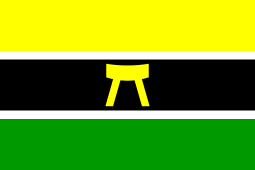Kwame Nkrumah University of Science and Technology
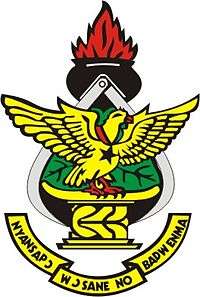 Arms of the Kwame Nkrumah University of Science and Technology | ||||||||||||||||||
| Motto | Ashanti Twi: Nyansapɔ wɔsane no badwenma[1] | |||||||||||||||||
|---|---|---|---|---|---|---|---|---|---|---|---|---|---|---|---|---|---|---|
Motto in English | The knot of wisdom is untied only by the wise[1] | |||||||||||||||||
| Type | Public | |||||||||||||||||
| Established | 1952[2] | |||||||||||||||||
| Chancellor | King Osei Tutu II[3] (Asantehene) | |||||||||||||||||
| Vice-Chancellor | Professor Kwasi Obiri-Danso[4] | |||||||||||||||||
| Students | 42,590 (2016) | |||||||||||||||||
| Undergraduates | 21,285 | |||||||||||||||||
| Postgraduates | 2,306 | |||||||||||||||||
| Location |
Kumasi, Ashanti Region, Ghana 06°41′5.67″N 01°34′13.87″W / 6.6849083°N 1.5705194°W | |||||||||||||||||
| Campus | Suburban area | |||||||||||||||||
| Colours |
| |||||||||||||||||
| Affiliations | See below | |||||||||||||||||
| Website | www.knust.edu.gh | |||||||||||||||||
|
| ||||||||||||||||||
Kwame Nkrumah University of Science and Technology (KNUST) is a university in Kumasi, Ashanti, Ghana. The Kwame Nkrumah University of Science and Technology is the public university established in the country, as well as the largest university in Kumasi Metropolis and Ashanti. KNUST has its roots in the plans of the King Asantehene Agyeman Prempeh I to establish a university in Kumasi as part of his drive towards modernization of his Ashanti kingdom. This plan never came to fruition due to the clash between British empire expansion and the desire for King Prempeh I to preserve his Ashanti kingdom's independence.
However, his younger brother and successor, King Asantehene Agyeman Prempeh II, upon ascending to the Golden Stool in 1935, continued with this vision. Events in the Gold Coast in the 1940s played into his hands. First there was the establishment of the University College of the Gold Coast. Second there were the 1948 riots and the consequent Watson Commission report which recommended that a university of sciences be established in Kumasi. Thus, in 1949, the dream of the Prempehs became a reality when building started on what was to be called the Kumasi College of Technology. [5]
The Kumasi College of Technology offered admission to its first students to the engineering faculty in 1951 (they entered in 1952), and an Act of Parliament gave the university its legal basis as the Kumasi College of Technology in 1952. The nucleus of the college was formed from 200 teacher training students transferred from Achimota in the Greater Accra Region. The college was affiliated to the University of London. In 1961, the college was granted full university status.[6]
The main university campus, which is about seven square miles in area, is about eight miles (13 km) to the east of Kumasi, the Ashanti Regional capital.[7]
History
Early history
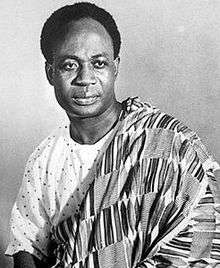
The Kumasi College of Technology opened officially on 22 January 1952 with 200 teacher training students transferred from Achimota, to form the nucleus of the new college. In October 1952, the School of Engineering and the Department of Commerce were established and the first students were admitted. A Pharmacy Department was established in January 1953, with the transfer of the former School of Pharmacy from Korle Bu Teaching Hospital, Accra, to the college. The department ran a two-year comprehensive course in Pharmacy leading to the award of the Pharmacy Board Certificate. A Department of Agriculture was opened in the same year to provide ad hoc courses of varying duration, from a few terms to three years, for the Ministry of Agriculture. A Department of General Studies was instituted to prepare students for the Higher School Certificate Examinations in Science and Arts subjects and to give instruction in subjects as requested by the other departments.
From 1952 to 1955, the School of Engineering prepared students for professional qualifications only. In 1955, the school embarked on courses leading to the University of London Bachelor of Engineering External Degree Examinations.
In 1957, the School of Architecture, Town Planning and Building was inaugurated. Its first students were admitted in January 1958, for professional courses. As the college expanded, it was decided to make the Kumasi College of Technology a purely science and technology institution. In pursuit of this policy, the Teacher Training College, with the exception of the Art School, was transferred in January 1958, to the Winneba Training College; in 1959 the Commerce Department was transferred to Achimota to form the nucleus of the present School of Administration of the University of Ghana, Legon.
In December 1960, the Government of Ghana appointed a University Commission to advise it on the development of university education, in connection with the proposal to transform the University College of Ghana and the Kumasi College of Technology into an independent University of Ghana. Following the report of the commission which came out early 1961, the government decided to establish two independent universities in Kumasi and Legon, Accra. The Kumasi College of Technology was thus transformed, under the supervision of R. P. Baffour, into a full-fledged University Kwame Nkrumah University of Science and Technology by an Act of Parliament on 22 August 1961. The name honors Kwame Nkrumah, the first prime minister and later president of Ghana.
The name was changed to University of Science and Technology after the Revolution of 24 February 1966. The University of Science and Technology was officially inaugurated on Wednesday, 20 November 1961. However, another act of Parliament (Act 559 of 1998) changed the name back to its original version, the Kwame Nkrumah University of Science and Technology, Kumasi.[2]
Organization and administration
Principal officers
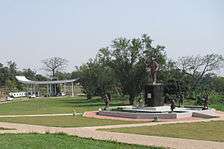
The principal officers of the university are the chancellor, chairman of the University Council and vice-chancellor. As of 2018, the position of chancellor was held by the Asantehene Otumfuo Osei Tutu II.
Governing body
Governance is carried out by the University Council, primarily through the Academic Board, which is responsible for:
- formulating and carrying out the academic policy of the university
- devising and regulating the courses of instruction and study, and supervising research
- regulating the conduct of examinations and the award of degrees, diplomas and certificates
- advising the University Council on the admission of students and the award of scholarships
- reporting on such matters as may be referred to it by the University Council
Student participation in university administration
Students participate in the administration of the university through their representatives serving on the University Council, Academic Board, the Welfare Services Board, Faculty and Departmental Boards, Residence Committee, Library Committee and on the Hall Councils.[8]
Collegiate system
KNUST has, since January 2005, transformed from its previous centralized system of administration into a decentralized collegiate university. Under this system, the faculties have been condensed into six colleges.
The university had been administered on the faculty-based system. This led to administrative difficulties as new faculties and institutes were created to meet the ever-growing academic pursuits of students. To solve this problem, a collegiate system was officially adopted on 29 November 2004. On 5 April 2005, the pioneering provosts were inducted and invested into office at the Great Hall of the KNUST.
The colleges are semi-autonomous, which means that they are given the power to largely run on their own without much dependence on the central administration for financial support. A college registrar, finance officer and librarian assist the provosts. Under them are the faculties, centres and institutes, headed by deans and directors. As heads of the colleges, the provosts provide academic and administrative leadership for the colleges and oversee their overall running.[9]
Housing and Accommodation
There are numerous KNUST approved hostels mostly within close proximity to main campus. Students of all financial backgrounds have their accommodation needs catered for. There are six halls of residence at the Kumasi campus, each administered by a hall council consisting of senior and junior members. The executive head is the hall master, who is assisted by a senior tutor. There is a hall bursar and other supporting staff.[10]
Halls of residence
- Africa Hall is the only all-female hall in the university. It was first occupied by students on 14 October 1967. Members of the hall are known as Domites. A majority of the female senior members are assigned to Africa Hall as Fellows. Dome has 192 inhabitable rooms, with a student population of about 514.[10]
- Independence Hall was officially opened in February 1959 to commemorate the attainment of Ghana's independence on 6 March 1957, and was the first permanent hall of residence. Women were admitted to the hall for the first time in 1991. Members are known as Spartans.[10]
- Queen's Hall was named in honour of Queen Elizabeth II of Great Britain and was officially opened in November 1959 by the Duke of Edinburgh. The Queen visited the hall in 1961 during her state visit to Ghana. Queen's Hall is co-educational and houses a student population of 840, with 294 rooms. Members are usually known as Royals.[10]
- Republic Hall, nicknamed Akukɔ Repo, is a mixed hall with about 850 local and international students. It was named to commemorate Ghana's attainment of republic status in 1960, and was officially opened in 1961. Women were admitted to the hall for the first time in 1991. The main hall has 198 rooms, and there are 96 rooms in the annex block. Residents of Republic Hall are known as Moguls.[10]
- Unity Hall is the largest hall in West Africa with an original accommodation capacity of 432 rooms and presently with 48 extra flats housed in the building. It is an all-male hall with facilities nicknamed The Twin Towers. Members are known as Continentals. The student population is more than 1880. The hall welcomed its first residents on 16 October 1968.It is the only traditional hall on campus with a study room equipped with a wireless internet connection. It is popularly known as Conti. It is currently the largest male hall in Ghana and west Africa.[10]
- University Hall is the real name of the first all-male hall in KNUST which is popularly known as Katanga.[10]
Hostels
About 60% of the student population is non-resident. There are private hostels around the campus and in Kumasi for students who, as a result of the limited facilities/rooms, could not be admitted as resident students.[11]
There are facilities on campus where non-resident students can rest between lectures and study before they leave for their homes and hostels.
In January 2014, the top floor of the Crystal Rose Hostel[12] caught fire while most students were on vacation. The cause of the fire is still not known.[13]
International students
There is a large multinational international community at KNUST as a result of the high standards of education. There is an international student association that sees to the interests of foreign students such as accommodation, orientation and campus tours.[14]
Academics

From the 2010/11 academic year some of the colleges operate a two-tier system, while others maintain their three-tier system.
Colleges under the three-tier system (Provost/Dean/Head of Department):
College of Agriculture and Natural Resources
- Faculty of Agriculture
- Department of Agricultural Economics, Agribusiness and Extension
- Department of Animal Sciences
- Department of Crop and Soil Sciences
- Department of Horticulture
- Faculty of Renewable Natural Resources
- Department of Agroforestry
- Department of Fisheries and Watershed Management
- Department of Silviculture and Forest Management
- Department of Wildlife and Range Management
- Department of Wood Science and Technology
- Faculty of Forest Resources Technology
- Department of Ecotourism and Forest Recreation
- Department of Land Reclamation and Rehabilitation
- Department of Social Forestry
- Department of Wood Processing and Marketing
College of Health Sciences
- Faculty of Allied Health Sciences
- Department of Medical Laboratory Technology
- Department of Nursing
- Department of Sonography
- Department of Sports and Exercise Science
- Faculty of Pharmacy and Pharmaceutical Sciences
- Dental School
- School of Medical Sciences
- School of Veterinary medicine
College of Humanities and Social Sciences
- Faculty of Law[15]
- Faculty of Social Sciences
- Department of Economics
- Department of English
- Department of Geography and Rural Development
- Department of History and Political Studies
- Department of Modern Languages
- Department of Religious Studies
- Department of Sociology and Social Work
- School of Business
Colleges under the two-tier system (Provost/Head of Department):
College of Arts and Built Environment
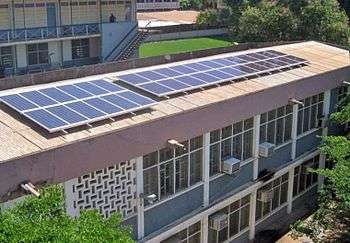
- The College of Art and Built Environment formerly known as College of Architecture and Planning came into existence in January 2005 as part of the restructuring of the University into a Collegiate System. In the restructuring, the Faculty of Environmental and Development studies (FEDS) and the Institute of Land Management and Development (ILMAD) were merged to form the College. FEDS comprised three teaching departments: Department of Architecture, department of Building Technology and Department of Housing and Planning Research. ILMAD comprised two departments, Department of Land Economy and the Land Resources Centre. The college currently comprises two faculties, ten teaching departments and one research institute:
- Department of Communication Design
- Department of General Art Studies
- Department of Painting and Sculpture
- Department of Integrated Rural Art/Industry
- Department of Industrial Art
- Department of Publishing Studies
- Department of Architecture
- Department of Building Technology
- Department of Planning
- Department of Land Economy
- Department of Architecture
- Department of Building Technology
- Department of Land Economy
- Department of Planning
- Centre for Settlements Studies
- Centre for Land Studies
College of Engineering
- Department of Agricultural Engineering
- Department of Aerospace Engineering
- Department of Chemical Engineering
- Department of Civil Engineering
- Department of Computer Engineering
- Department of Electrical Engineering/Electronic Engineering & Telecommunication Engineering
- Department of Geological Engineering
- Department of Geodetic Engineering
- Department of Geomatic Engineering
- Department of Materials Engineering
- Department of Mechanical Engineering
- Department of Petroleum Engineering
- Department of Reproductive Engineering
College of Science
- Department of Biochemistry and Biotechnology
- Department of Chemistry
- Department of Computer Science
- Department of Environmental Science
- Department of Food Science and Technology
- Department of Mathematics
- Department of Optometry and Visual Science
- Department of Physics
- Department of Theoretical and Applied Biology
Institute of Distance Learning
In the year 2005, the KNUST adopted distance learning as a viable complement to the conventional face-to-face system of education. This decision was made to offer opportunity for people to pursue academic programmes with the Kwame Nkrumah University of Science and Technology, while still on full-time employment.[9][17]
In October 2007, the Academic Board changed the status of the Faculty of Distance Learning to the Institute of Distance Learning.[9]
Library and digital resources
The KNUST Library provides information in electronic and print formats to staff and students mainly to support teaching, learning and research in science and technology for national development. It is a depository library for all materials published in Ghana and for international institutions and organisations like the World Bank and other United Nations Agencies.[18]
Digital services are available through the Open Educational Resource (OER) as well as the DSpace repository.[19]
- The Open Educational Resources (OER)[20] component of the Kwame Nkrumah University of Science and Technology fosters collaboration on curricula, course materials, and content; generates connections between disciplines, teachers, and learners; and inspires use of educational materials in a more effective way.[21]
- KNUST Online Repository[22] is the university's digital repository. Data for the repository is still being added on to.
Affiliated institutions
- Accra Institute of Technology
- Akim State University College
- All Nations University College
- Central University College
- DataLink University College(DLUC)
- Garden City University College
- Ghana Telecom University College
- Ho Polytechnic
- Osei Tutu II Institute for Advanced ICT Studies
- Regent University College
- Spiritan Institute / Spiritan University College[23]
Research centres
- Bureau of Integrated Research and Development
- Centre for Biodiversity Utilisation and Development (CBUD)
- Centre for Cultural and African Studies
- Centre for Human Studies
- Dairy/Beef Research Station
- The Energy Center[25]
- Kumasi Center For Collaborative Research[26]
- National Centre for Mathematical Sciences
- Technology Consultancy Centre (TCC)
Notable alumni
In Government and Diplomacy,Vice-President of Ghana(2000-2008);Aliu Mahama studied at KNUST.Chief Justice of Ghana;Edward Kwame Wiredu was also a student at KNUST. Former first lady of Ghana,Nana Konadu Agyeman-Rawlings is an alumni.Several notable Ghanaian cabinet ministers have also graduated from the institution including Haruna Esseku and current education minister,Matthew Opoku Prempeh. UN Secretary-General and Nobel Peace Prize Laureate in 2001,Kofi Annan had a part of his education at KNUST. Kwaku Aning,Hackman Owusu-Agyeman are other diplomats who graduated from KNUST. Notable Graduates from KNUST College of Engineering include Thomas Mensah,the inventor whose discoverey in fibre optics made fibre optics commercial throughout the world, Alex Mould;former CEO of GNPC,Benjamin Asante,CEO of Ghana Gas and Charles Darku,former CEO of GRIDCO and Tullow Ghana Limited. The female novelist writer,Amma Darko was attended KNUST. Actors,John Dumelo and Chris Attoh attended KNUST.
References
- 1 2 "The Emblem". Archived from the original on 25 June 2014. Retrieved 7 July 2014.
- 1 2 http://www.knust.edu.gh/pages/sections.php?siteid=knust&mid=14&sid=94&id=115%5Bpermanent+dead+link%5D History of Kwame Nkrumah University of Science and Technology |accessdate=2009-10-29
- ↑ "The Chancellor". Official Website. Kwame Nkrumah University of Science and Technology. Archived from the original on 29 September 2014. Retrieved 4 September 2014.
- ↑ "KNUST appoints Prof. Kwasi Obiri-Danso as new VC". citi fm. 19 May 2016. Retrieved 27 September 2016.
- ↑ "January 22, 1952: Kumasi College of Technology is established". Edward A. Ulzen Memorial Foundation. Retrieved 2018-06-09.
- ↑ G. F. Daniel (17 April 1998). "THE UNIVERSITIES IN GHANA". Development of University Education in Ghana. University of Ghana. Retrieved 10 March 2007.
- ↑ "Kwame Nkrumah University of Science & Technology, KUMASI". Universities. Universities of Ghana Overseas Office. Retrieved 11 March 2007.
- ↑ "KNUST Students' Representative Council". Official Website. Kwame Nkrumah University of Science and Technology. Archived from the original on 27 August 2009. Retrieved 29 October 2009.
- 1 2 3 The Vice-Chancellor's Report, Kumasi: University Press - KNUST, June 2009
- 1 2 3 4 5 6 7 "Halls of Residence". Official Website. Kwame Nkrumah University of Scienhostel tice and Technology. Archived from the original on 18 June 2013. Retrieved 29 October 2009.
- ↑ "Hostel Tips for students". Official Website. Kwame Nkrumah University of Science and Technology. Archived from the original on 18 June 2013. Retrieved 29 October 2009.
- ↑ Felix A. Baidoo. "Investigations begin into KNUST hostel fire". Daily Graphic. Retrieved 11 January 2014.
- ↑ "Fire engulfs KNUST hostel". www.myjoyonline.com. Retrieved 10 January 2014.
- ↑ "International Students - Kwame Nkrumah University of Science and Technology". www.knust.edu.gh. Retrieved 9 April 2018.
- ↑ "KNUST - Faculty of Law". Official Website. KNUST Faculty of Law. Retrieved 30 October 2009.
- ↑ "Colleges". Kwame Nkrumah University of Science & Technology. Archived from the original on 2013-06-16. Retrieved 14 May 2018.
- ↑ Erastus Asare Donkor (24 November 2005). "KNUST Inaugurates Faculty of Distance Learning". Modern Ghana, Regional News. Retrieved 30 October 2009.
- ↑ "KNUST Library". Official Website. Kwame Nkrumah University of Science and Technology. Retrieved 29 October 2009.
- ↑ DSpace repository Archived 26 November 2011 at the Wayback Machine.
- ↑ "Open Educational Resources (OER)". Official Website. Kwame Nkrumah University of Science and Technology. Archived from the original on 13 October 2009. Retrieved 29 October 2009.
- ↑ "Kwame Nkrumah University of Science and Technology - Digital Library Services". Official Website. Kwame Nkrumah University of Science and Technology. Archived from the original on 12 October 2009. Retrieved 29 October 2009.
- ↑ "Online Repository (KNUST DPSACE)". Official Website. Kwame Nkrumah University of Science and Technology. Retrieved 29 October 2009.
- ↑ Spiritan University College Archived 22 April 2012 at the Wayback Machine.
- ↑ Institutions affiliated to KNUST
- ↑ The Energy Center Archived 13 October 2009 at the Wayback Machine.
- ↑ Kumasi Center For Collaborative Research Archived 18 September 2009 at the Wayback Machine.
External links
Coordinates: 06°41′5.67″N 01°34′13.87″W / 6.6849083°N 1.5705194°W
